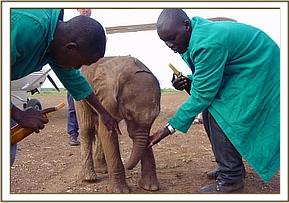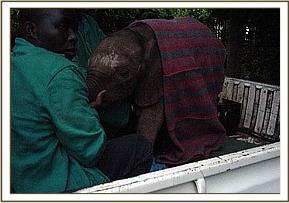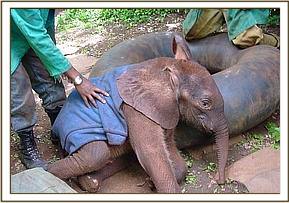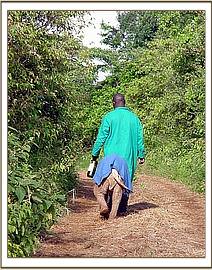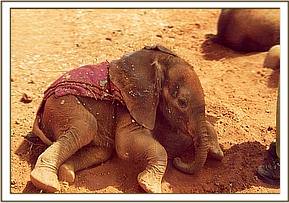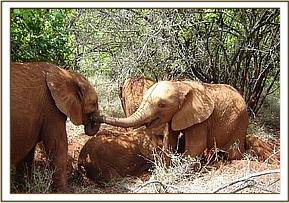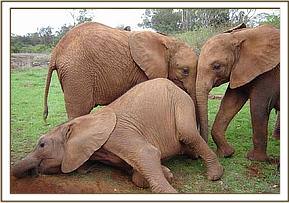










Now living wild, where she is a mother of one
Current age
22 years old
Gender
Female
Rescued date
9 June 2003
Rescue location
Samburu, Loisaba Ranch
Date of birth (estimate)
1 June 2003
Reason orphaned
Man-made cause for separation
Age at rescue
1 week old (approx)
Current location
Living Wild
By now, the calf was being held at the Police Post in Ol Donyo Nyiro town. Already a day had past and the time in Nairobi was 1 p.m. It was important to establish (l) the exact location of this remote town and Police Post within the vastness of Laikipia District, (2) whether the calf was, in fact, still alive, before incurring the expense of mobilising an Aircraft (3) that transport be sourced to bring the calf to the nearest airfield, having found out exactly where the nearest Airstrip is and (4) assuming that the calf was still living, that it be given rehydration salts a.s.a.p. to counter death through dehydration and stress.
Thank heavens for mobile phones and Tom Silvester, the extremely elephant-friendly Manager of Loisaba Ranch who knew exactly where Ol Donyo Nyiro town was and who told us that the nearest airfield was his own at Loisaba. Very kindly he offered his help and leaping into his vehicle, headed for the Police Post in question, a journey that would take at least 45 minutes there and 45 minutes back, driving on rutted dirt roads. We requested that he phone us with news of the elephant as soon as he got there.
Finally news came from Tom Silvester. The calf was, indeed, still alive and quite strong, but obviously newborn, the umbilicus still attached. Now the plane could be given the green light to take off heading for Loisaba Airfield an hour away with very little time at their disposal in order to be back in Nairobi with its precious cargo in daylight!
At the remote Police Post Tom Silvester was encountering the usual bureaucratic red tape because the authorities needed official clearance from Nairobi to release the calf. Radio relays to K.W.S. managed to solve this problem. The tribesmen who had rescued the calf, were reluctant to see it go, because already it was “their” elephant, following them trustingly and nuzzling them with its baby trunk. Tom assured them that it would be in safe hands, and soon he was on his way, heading back to Loisaba Airfield. There he had just a 15 minute wait before the plane was circling overhead, which had taken off from Nairobi the moment we had positive news.
It was 6.45 p.m. in the evening before little “Sunyei” arrived in the Nairobi Nursery.
She was given the usual antibiotic precautionary injection, hungrily downed 3 pints of milk and 3 pints of re-hydration, taking another 9 pints at intervals throughout the night, and in between, sleeping quietly, too young to be subjected to the usual trauma that is part and parcel of losing a mother and family. Having well-intentionally been given cow’s milk by her Samburu rescuers, we anticipated difficulties with the stomach, but apart from that, Sunyei was not in bad shape, although quite lean, coming as she did from an elephant population constantly at risk and constantly on the move in an extremely arid part of the world.
By now, the calf was being held at the Police Post in Ol Donyo Nyiro town. Already a day had past and the time in Nairobi was 1 p.m. It was important to establish (l) the exact location of this remote town and Police Post within the vastness of Laikipia District, (2) whether the calf was, in fact, still alive, before incurring the expense of mobilising an Aircraft (3) that transport be sourced to bring the calf to the nearest airfield, having found out exactly where the nearest Airstrip is and (4) assuming that the calf was still living, that it be given rehydration salts a.s.a.p. to counter death through dehydration and stress.

View diary updates from across all our orphan units as written by the Keepers

We are overjoyed to share the news that Makena has given birth to a beautiful baby girl, named Merri. Her journey to motherhood hasn’t been an easy one — in fact, it has been 20 years in the making, with too much heartbreak along the way — which makes this new arrival all the more special.
Born in the first rays of day break, ‘Siku’ is the Swahili word for ‘day’ - a fitting name given she was born at day break. Siku was still wobbly and pink behind the ears when we first met her, as her mother Sunyei proudly presented her perfect and first baby to her beloved human family hours after giving birth. Read more
On 16th November 2021, Sunyei appeared at the Ithumba mud bath with a newborn daughter by her side. We named her Saba, which means “seven” in Swahili. It’s a most fitting name, as she is the seventh calf born to our Ithumba ex orphans thus far in 2021.
She is growing up alongside her big sister, Siku, who is four years her senior. Read more
On 1st May 2025, ex-orphan Sunyei and her team made a brief appearance at the Ithumba mud bath with a very special delivery — her brand new baby girl! We named her Subiri, which means 'wait' in Swahili, because Sunyei seemed to have an especially long pregnancy this time around. Read more.
By adopting, you play a vital role in the life of an orphaned elephant, rhino, or giraffe — helping us provide the round-the-clock, loving attention each one needs and deserves over many years, so they can ultimately reclaim their place in the wild.
Your adoption supports the 100+ orphans in our care at any given time, covering the cost of milk and food supplies, Keepers' salaries, veterinary treatment, and other essentials.

Celebrate your adoption with a personalised certificate, ready for you or your lucky gift recipient to print and display!

Each month, we send a detailed update about our Orphans’ Project direct to your email inbox, featuring photos, stories, and special highlights.

From the latest Keepers’ Diaries to a downloadable image gallery and more, adopters have exclusive access to our content library.
